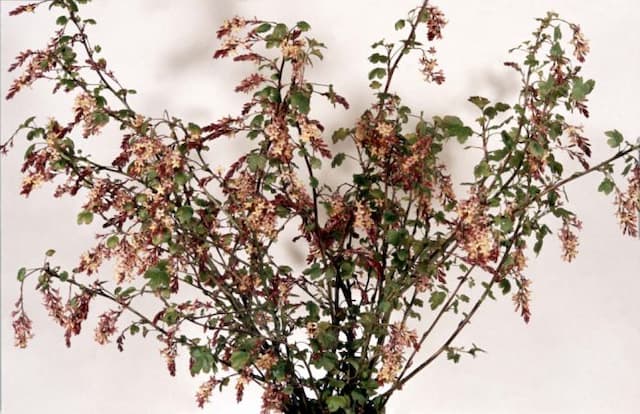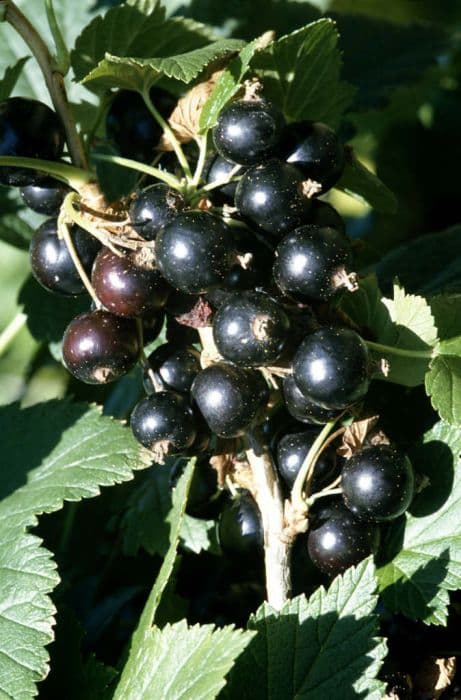Blackcurrant Ribes nigrum 'Big Ben' (PBR) (B)
ABOUT
The 'Big Ben' blackcurrant is a fruit-bearing plant that showcases clusters of glossy, deep purple to almost black berries when ripe. Each berry is notably larger than what is typically seen in other blackcurrant varieties. The foliage of the plant is comprised of broad, green leaves with a slightly serrated edge, exuding a subtle, aromatic fragrance. In spring, the blackcurrant plant exhibits small, tubular flowers that range in color from a pale pink to a creamy white. These blooms eventually give way to the heavy bunches of fruit that the plant is named for. Overall, the 'Big Ben' blackcurrant presents a lush appearance with its combination of vibrant foliage and luscious fruit.
About this plant
 Names
NamesSynonyms
Blackcurrant 'Big Ben', Big Ben Blackcurrant.
Common names
Ribes nigrum 'Big Ben' (PBR) (B)
 Toxicity
ToxicityTo humans
The plant commonly known as blackcurrant, including the variety Ribes nigrum 'Big Ben', is not toxic to humans. In fact, blackcurrants are edible and are often used in culinary applications for their tart flavor. They are a good source of vitamins and nutrients. However, it is always important to consume plants that have been positively identified and are free from pesticides or other harmful substances.
To pets
Blackcurrant, including the Ribes nigrum 'Big Ben' variety, is not commonly known to be toxic to pets such as dogs and cats. These plants, including their berries, are typically considered safe for pets if consumed in modest amounts. However, individual animals might have differing sensitivities, and it is always best to prevent pets from ingesting large quantities of any non-food plant as it can possibly cause gastrointestinal upset or an unexpected allergic reaction. If a pet shows adverse symptoms after ingestion, consulting a veterinarian is advised.
 Characteristics
CharacteristicsLife cycle
Perennials
Foliage type
Deciduous
Color of leaves
Green
Flower color
Greenish-yellow
Height
5 feet (1.52 meters)
Spread
4 feet (1.22 meters)
Plant type
Shrub
Hardiness zones
5
Native area
Europe
Benefits
 General Benefits
General Benefits- Large Fruits: 'Big Ben' produces exceptionally large berries that are easy to pick and ideal for culinary use.
- High Yield: This cultivar is known for its prolific fruit production, providing an abundant harvest.
- Sweet Flavor: The fruits have a sweet and intense flavor, enjoyable when eaten fresh or used in recipes.
- Hardiness: Ribes nigrum 'Big Ben' is a hardy plant that can withstand cold climates, broadening its growing range.
- Disease Resistance: It shows good resistance to common diseases that affect blackcurrants, like powdery mildew and leaf spot.
- Attractive Foliage: The plant features attractive leaves that can enhance the aesthetic appeal of a garden space.
- Wildlife Friendly: The flowers attract bees and other pollinators, while the fruits are a food source for birds.
- Easy to Grow: 'Big Ben' is relatively easy to cultivate, making it suitable for both experienced and novice gardeners.
- Compact Growth: Its compact growth habit makes it appropriate for smaller gardens or spaces where room is limited.
 Medical Properties
Medical Properties- Antioxidant properties: Blackcurrant (Ribes nigrum) is known to be rich in anthocyanins and vitamin C, contributing to its antioxidant capacity which may help protect cells from damage by free radicals.
- Anti-inflammatory properties: Blackcurrant seed oil contains gamma-linolenic acid (GLA), which has been suggested to have anti-inflammatory effects.
- Immune support: The high vitamin C content in blackcurrants can contribute to the normal function of the immune system.
- Visual health support: Blackcurrants contain substances like anthocyanins, which are thought to be beneficial for eye health, particularly in improving visual fatigue and promoting blood circulation in the eyes.
- Cardiovascular health: Regular consumption of blackcurrants has been associated with better circulation, reduction of blood pressure, and potential cardiovascular benefits due to their anthocyanin and polyphenolic content.
 Air-purifying Qualities
Air-purifying QualitiesThis plant is not specifically known for air purifying qualities.
 Other Uses
Other Uses- As a natural dye: The fruit of the black currant can be used to create natural dyes for textiles, providing shades of purple and blue depending on the mordant used.
- In perfumery: The essential oil derived from black currant buds is sometimes used in the perfume industry for its rich, fruity aroma.
- Photography: The juice of black currants can be used as a natural pigment in certain alternative photography processes, such as anthotypes.
- Insect repellent: Black currant leaves, when crushed, can act as a mild, natural insect repellent due to their strong scent.
- Flavoring agent: The berries can be used to flavor vinegars, imparting a unique fruity touch to salad dressings and marinades.
- As a woodworking stain: The juice or a decoction of berries can be employed to stain wood, providing a non-toxic, natural colorant.
- In ornamental arrangements: The foliage and sometimes even the fruit clusters can be used in floral arrangements for their aesthetic appeal.
- Educational tool: Black currant plants can be used in school gardens to teach children about plant biology and fruit production.
- Wildlife habitat: The bush provides shelter and nesting sites for birds and small mammals in the garden.
- Erosion control: Black currant shrubs, with their extensive root systems, can be planted to help prevent soil erosion in certain landscapes.
Interesting Facts
 Feng Shui
Feng ShuiThe Blackcurrant is not used in Feng Shui practice.
 Zodiac Sign Compitability
Zodiac Sign CompitabilityThe Blackcurrant is not used in astrology practice.
 Plant Symbolism
Plant Symbolism- Abundance and Vitality: Blackcurrant, which Ribes nigrum 'Big Ben' is a variety of, is known for its generous yield of fruit. The lush berries can symbolize abundance and the vitality of nature, as the plant is hardy and robust.
- Sweetness and Pleasure: The sweet-tasting fruit of the blackcurrant plant may symbolize the sweetness and pleasures of life, representing the enjoyment of sensory experiences.
- Healing and Medicinal Properties: Historically, blackcurrants have been used for their medicinal properties. They may symbolize healing and the nurturing of health, as they are rich in Vitamin C and antioxidants.
- Protection and Safety: In folklore, some berries, including blackcurrants, were thought to ward off negative forces. The blackcurrant plant could symbolically represent protection and safety against harm.
 Water
WaterBlackcurrant 'Big Ben' should be watered deeply once a week during dry spells, ensuring the soil is moist but not waterlogged. In the growing season, increase watering to twice a week, providing about 2 gallons per plant each time. During fruit set and fruit development, consistent moisture is crucial, so check the soil moisture regularly. Reduce watering once the fruit has been harvested and as the plant prepares for dormancy in fall. Always adjust your watering to weather conditions and soil type, as overwatering can lead to root rots.
 Light
LightBlackcurrants including 'Big Ben' thrive in full sun to partial shade. They should be planted in a spot that receives at least 6 to 8 hours of sunlight daily. While they can tolerate light shade, more sun exposure will result in better fruit production and a healthier plant.
 Temperature
TemperatureBlackcurrant 'Big Ben' is hardy and can tolerate winter cold as low as 20 degrees Fahrenheit, but it should not be exposed to prolonged temperatures below this. In the growing season, it performs best in temperatures ranging from 60 to 75 degrees Fahrenheit, though it can survive in summer heat up to 85 degrees Fahrenheit. The plant requires a period of winter chill for successful fruiting.
 Pruning
PruningPrune Blackcurrant 'Big Ben' plants in the dormant season, typically late winter to early spring, to maintain their shape and promote healthy growth. Remove any dead, diseased, or crossing branches to improve air circulation. Older branches should be pruned out every few years to encourage new growth and to maintain a productive plant. Pruning is also important to facilitate harvesting and to ensure optimal fruit size and quality.
 Cleaning
CleaningNot needed
 Soil
SoilBlack currants like 'Big Ben' thrive in well-drained, fertile loamy soil with a pH between 6.5 and 7.0. Amend soil with compost or well-rotted manure before planting to enrich the ground and improve structure. Mulching is beneficial to maintain moisture and suppress weeds.
 Repotting
RepottingBlack currants typically don't need repotting as they are grown in open ground rather than containers. If grown in pots, repot every 2-3 years in late winter or early spring before new growth begins.
 Humidity & Misting
Humidity & MistingBlack currants, such as 'Big Ben', prefer outdoor conditions where humidity is naturally regulated. They are quite hardy and do not require specific humidity levels but grow well in a temperate climate.
 Suitable locations
Suitable locationsIndoor
It's tough to grow black currants indoors; they need full sun and chill hours.
Outdoor
Plant black currants in full sun or partial shade; ensure well-drained soil.
Hardiness zone
5-8 USDA
 Life cycle
Life cycleThe 'Big Ben' blackcurrant (Ribes nigrum 'Big Ben') begins its life cycle with germination from seed, although commercially it is commonly propagated using cuttings to maintain the specific characteristics of this cultivar. Following rooting, the young plant enters a vegetative stage, developing a bushy structure with characteristic lobed leaves. In spring, it produces racemes of small, bell-shaped flowers that are pollinated by insects, leading to the formation of clusters of large, glossy black currants by midsummer. Fruits mature typically in July, after which they are harvested, and the plant begins to prepare for dormancy. During fall, leaves change color and drop off as the plant enters a period of dormancy over winter, conserving energy for the next growing season. In subsequent years, the plant repeats this cycle of growth, flowering, fruiting, and dormancy, potentially producing for up to 15 years or more under optimal conditions.
 Propogation
PropogationPropogation time
Spring to Summer
The most popular method of propagating Blackcurrant 'Big Ben' is through hardwood cuttings. This process is typically done in late fall after the leaves have dropped or in early spring before new growth begins. Cuttings should be taken from healthy, mature stems, about 8 to 10 inches long, with a diameter of about 1/4 to 1/2 inch (approximately 6 to 12 mm). The cut end of the cutting is dipped in rooting hormone to encourage root development and then planted in a pot with moist potting mix or directly into the ground in a sheltered location. It's crucial to keep the soil consistently moist until the cuttings have rooted, which can take several weeks. Once rooted, the new plants can be transplanted to their final location in the garden.









